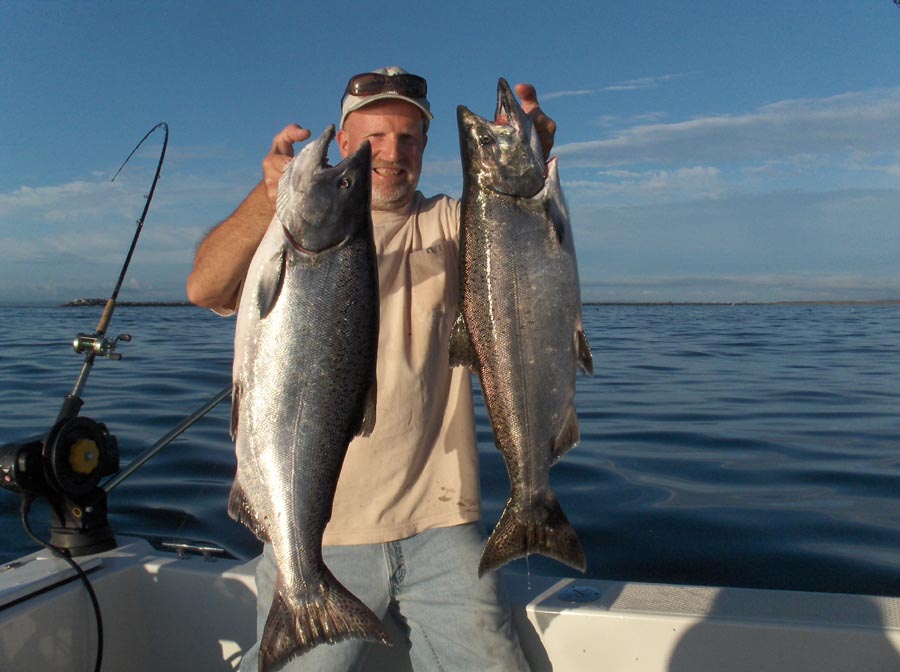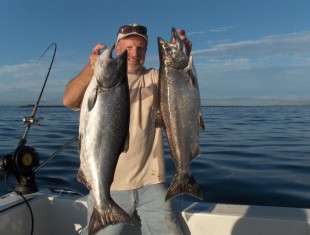
The Chinook sport fishing season opened at Westport on May 31st this year for two hatchery kings per day until June 13th. Steve Thorniley and I have fished this early season three years in a row and have done very well. Many of these May and June Chinook off Westport are the tail end of the spring Chinook run and the main run of summer Chinook heading to the Sacramento and Columbia River systems.
A friend of ours lets us camp out in his back yard at Westport, so we took Steve’s motor home down there the first part of May for the halibut season.
We went out twice and caught our halibut and lingcod. The first trip out was in a friend’s 28-foot Grady White. Wow! That is quite a boat, with high sides and lots of deck space, but it has a little drinking problem with gasoline. But that’s the price of comfort on the high seas.
We went 28 miles north and fished in 700 feet of water, bouncing our jigs on the bottom. The next trip out we took Steve’s 23 foot boat out 10 miles southwest and banged two halibut and four lings in water about 180 feet deep.
We went back May 30th and bought two weeks moorage for the boat, and got all our salmon fishing gear ready for the next morning. Because of timing of the tides we wanted to be heading across the bar at first light. High tide was 2 a.m. and the low was 9 a.m. Going over the bar with an out-going tide with anything over a five-foot swell can get a little dicey.
We made it across the bar with no problems and headed five miles north and started fishing in 70 feet of water. The fishing was a little slow but we manage to put four kings in the box up to 18 pounds, but it took us until 3:30 in the afternoon to get that job done.
The next day we did the exact same thing. Fishing wasn’t great but we could hardly complain as some guys were having a hard time. Even a few charter boats got skunked. So we headed back home to get our fish vacuumed packed and in the freezer.
The third time out was a little slower for us, but we did put three beautiful hatchery kings in the box. The next day we had two kings on board when the northwest wind picked up. We took one wave over the side and we have a rule that when a wave comes in the boat it’s time to leave and head back to the marina!
On June 11th some charter boats found a bunch of salmon 23 miles to the southwest in 300 feet of water. Most of the fish were from 40 to 120 feet down.
The next day everyone was out there as salmon news travels fast around the marina. We put two nice hatchery Chinook in the boat, but had to release two gorgeous 20-pounders that were unclipped and considered wild. One guy on the VHF radio said he released 10 wild kings and never did put a salmon in his box that day.
The weather was nice that day except for the rain and a 15-knot south wind in the afternoon. The forecast for the next day sounded nasty, which was the last day of keeping two hatchery Chinook.
Northwest winds to 30 knots after midnight with an eight-foot swell and five- foot wave didn’t sound like our kind of fun. So we pulled the boat out and scrubbed her down, flushed the engine out, and broke fishing camp the next day.
We did manage to harvest 20 hatchery kings for the two week season and had a great time doing it. Now you can keep one Chinook per day either hatchery or wild and a hatchery Coho or two for a total of two salmon per day.
Our friend Paul Davis had his boat down there and camped with us in his motor home. Between our two boats we picked up four Japanese fishing floats. One was a very cool glass float about four inches in diameter, and the other three plastic ones about a foot across.
PELAGIC GOOSENECKS
The plastic floats had some strange looking marine life growing on the bottom half. With a little research I found out they were pelagic gooseneck barnacles (lepas anatifera). The large ones had a neck three inches long and about 3/8th of an inch in diameter with a white clam like shell at the end where the feeding and filter apparatuses are. When they open their shell and the feeding tentacles come out they look like an alien creature. They have the most unusual adhesive production system for gluing themselves to any object in the animal kingdom. Once scientists figure this out it could have huge commercial applications.
The pelagic goosenecks are found world-wide mainly where the water temperature is between 64 and 88 degrees. They have been attaching themselves to ships for hundreds of years and have spread globally, but many marine scientists disagree that ships had anything to do with them spreading to the far reaches of the planet. Within 20 miles of our coast the water may be to cold for them to reproduce, but they have off the coast of Norway on oil platforms.
These barnacles start breeding when they are an inch long. They have both male and female reproductive organs so they can fertilize themselves or a close neighbor, which is kind of handy. The eggs are brooded inside the mantle for a week before emerging as free floating larvae. If they are lucky enough they will find a floating object to attach to or die looking.
The barnacles will eat anything they can catch, even tiny shrimp and fish, but mostly really small stuff like plankton. Out in the middle of the Pacific north of Hawaii ‑ in the huge plastic garbage dump ‑ they have been found with a stomach full of tiny bits of plastic.
These pelagic goosenecks can live to be six years old or longer and are good eating, being the most common barnacle eaten by humans. They taste sweeter then lobster and can be found in some of the finer restaurants in the world.


